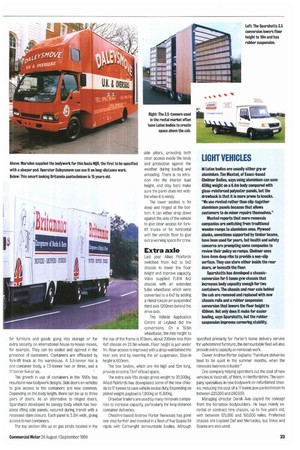IVIOVE
Page 34

Page 35

If you've noticed an error in this article please click here to report it so we can fix it.
Space rather than mileage is the priority for the high-cube vehicles used in the removals sector. Sharon Clancy reports on the range of options.
t is not uncommon to see pantechnicons, the high-cube vehicles used by the removals industry, which have been in service for more than 15 years. Even pantechnicons on international work are not high mileage vehicles because they spend a large part of their day standing still. And, in an industry that remains price sensitive, any investment in new vehicles has to be justified in improved productivity or flexibility.
Removals companies face competition not only from fellow professionals, but from rental companies offering vehicles specified to attract do-Ft-yourself customers.
The workhorses of the removals industry are 3.5-, 7.5and 17-tonne gvw vehicles. Operators need this mix of vehicle weights to keep costs under control.
Some bodybuilders predict sales of 12 to 15 tonnes gvw vehicles will expand over the next few years as the
appeal of 7.5-tonners diminishes in line with the number of people able to drive them on car ltences. Moving to 12 tonnes gvw or higher will not only improve productivity, but alleviate perennial worries about front axle overloading on 7.5-tonners.
The 17-tonner two-axle rigid is what most people imagine as a removals wagon. Many operators downplate the chassis to 14 or 15 tonnes gvw to save vehicle excise duty. Typical body lengths are 28ft (8.5m) to 32ft (9.8m), providing 2,200 to 2,450ft3 of internal space.
Increased flexibility
Lighter 3.5and 7.5-tonne vehicles are used both by professionals for smaller house moves and deliveries or stored containers and by people renting vehicles for DIY removals. While all 3.5-tonners tend to have Luton bodies to create extra space above the cab, some 7.5-tanners are specified with a sleeper cab instead. It increases their flexibility by allowing drivers to do longer overnight trips.
Some removals companies use drawbar-trailer rigs for larger house moves. They are a cheaper option than two vehicles and more manoeuvrable than an articulated outfit in residential streets.
The need for cubic capaody means that removals companies remain big fans of over-cab sleeper pods when many other operators have switched to sleeper cab trucks. Although sleeper pods use about 160m3 of capacity, that has less overall impact on cube than a longer-length sleeper cab.
Rather than cubic capacity, operators tend to talk about bodies in terms of the number of standard removals containers it can carry These wooden palletised boxes measure a standard 2.4x2.1x1.5m and are used for furniture and goods going into storage or for extra security on international house-to-house moves, for example. They can be sealed and opened in the presence of customers. Containers are offloaded by fork-lift truck at the warehouse. A 3.5-tonner has a ore-container body, a 7.5-tonner two or three, and a 17 tonrier five or six.
The growth in use of containers in the 1990s has resulted in new bodywork designs. Side doors on vehicles to give access to the containers are now common. Depending on the body length, there can be up to three pairs of doors. As an alternative to hinged doors, Sparshatts developed its canopy body which has twopiece lifting side panels, secured during transit with a recessed clam closure. Each panel is 3.3m wide, giving access to two containers.
The top section lifts up on gas struts located in the
side pillars, providing both clear access inside the body and protection against the weather during loading and unloading. There is no intrusion into the interior load height, and stay bars make sure the panel does not wobble when it is windy.
The lower section is 1m deep and hinged at the bottom. It can either drop down against the side of the vehicle to give clear access for forklift trucks or be horizontal with the vehicle floor to give extra working space for crew.
Extra axle
Last year Allied Pickfords switched from 4x2 to 6x2 chassis to lower the floor height and improve capacity. Volvo supplied FL614 4x2 chassis with an extended 5.8m wheelbase which were converted to a 6x2 by adding a Hendrickson air-suspended third axle 1200mm behind the drive axle.
The Vehicle Application Centre at Leyland did the conversions. On a 19.5in wheelbase, the ride height to the top of the frame is 873mm, about 200mm less than 4x2 chassis on 22.5in wheels. Floor height is just under 1m. Rear access is improved with a drop-well behind the rear axle and by lowering the air suspension. Step-in height is 600mm.
The box bodies, which are 4m high and 12m long, provide an extra 73rn3 of load space.
The extra axle lifts design gross weight to 20,500kg. Allied Pickfords has downplated some of the new chassis to 17 tonnes to save vehicle excise duty. Depending on plated weight, payload is 7,9004 or 11,300kg.
Drawbar trailers are used by many removals companies to increase capacity, particularly for long-distance container deliveries.
Cheshire-based Andrew Porter Removals has gone one step further and invested in a fleet of five Scania 94 rigids with Cartwright demountable bodies. Although
specified primarily for Porter's home delivery service for upholstered furniture, the demountable fleet will also provide extra capacity on removals work.
Owner Andrew Porter explains: "Furniture deliveries tend to be quiet in the summer months, when the removals business is busier."
One company helping operators cut the cost of new vehicles is Vancraft, of Ware, in Hertfordshire. The company specialises in new bodywork on refurbished chassis, reducing the cost of a 17-tonne gvw pantechnicon to between .£20,000 and /40,000.
Managing director Derek Avis copied the concept from the horsebox bodybuilders. He buys mainly exrental or contract hire chassis, up to five years old, with between 125,000 and 160,000 miles. Preferred chassis are Leyland Daf and Mercedes, but Volvo and Scania are also used.












































































































